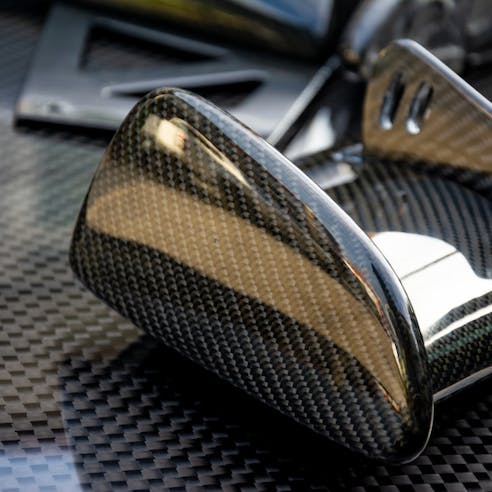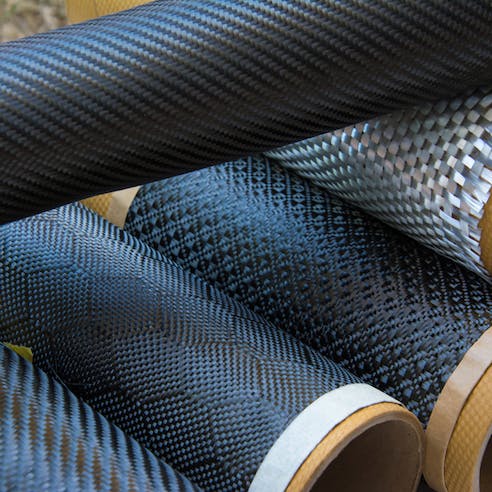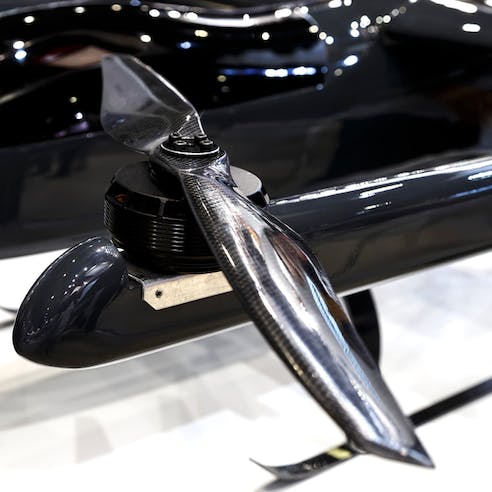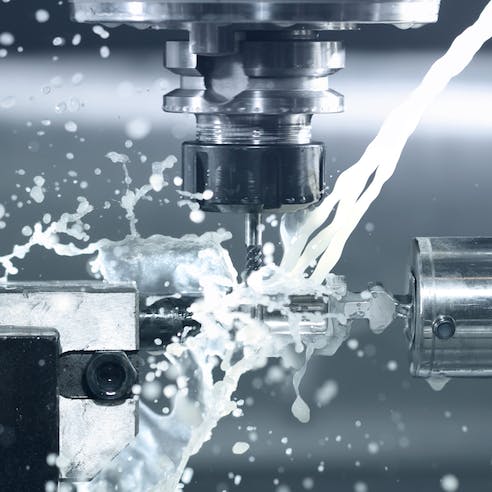Carbon Fiber Laser Cutting Service by Xometry
Xometry offers the highest quality carbon fiber laser cutting services and can assist in the production of parts with intricate and complex geometries and excellent surface finishes.
Carbon fiber laser cutting is often used to post-process carbon fiber components as well as to pre-cut carbon fiber fabric before epoxy infusion. Laser cutting is able to precisely and quickly cut carbon fiber parts without applying any mechanical force which may cause the material to crack or break. Carbon fiber laser-cut parts can include drone chassis, corrosion-resistant industrial brackets, or even satellite structural components. Xometry offers the highest quality carbon fiber laser cutting services.
What Is Carbon Fiber?
Carbon fiber is a composite material made by drawing what's known as a precursor, usually polyacrylonitrile (PAN), into a long strand. It is subsequently heated to extreme temperatures in an oxygen-free environment. The lack of oxygen prevents the PAN fiber from combusting and the high temperatures cause all the non-carbon atoms to vaporize, leaving behind a chain of interlocked carbon atoms.
Carbon fiber is often used to refer to a composite of woven carbon fiber fabric and a polymer, usually epoxy resin. Due to its flexibility, carbon fiber fabric can be draped over complex forms and the epoxy can be painted over the carbon fiber sheet to fill the voids between the fibers with epoxy. Alternatively, a technique known as vacuum infusion can be used to ensure that all the air gaps between the fibers are filled with epoxy. This composite has an excellent strength-to-weight ratio. Such materials are also referred to as CFRP (carbon fiber reinforced polymer) composites.
Carbon fiber parts usually have relatively thin walls. This makes them ideal for laser cutting. It can be challenging to laser cut carbon fiber composites as the epoxy will absorb the laser energy and evaporate before the laser has had a chance to cut through all the carbon fiber strands. However, CO2, Fiber, and Nd:YAG lasers are all able to successfully cut through carbon fiber. Specialized multi-wave laser cutters that make use of CO2 and fiber lasers in combination produce the best results.
Carbon Fiber Laser Cutting Advantages
Listed below are some common advantages of laser cutting carbon fiber components:
- Lightweight
- Strong
- Corrosion Resistant
- Versatility
- High Precision
- Low Thermal Expansion
- Increased Speed

Lightweight
Carbon fiber is widely used in applications in which low weight is required. Laser cutting these parts can create optimized designs by precisely cutting away any material that is not directly contributing to the overall strength of the part.
Strong
Carbon fibers on their own are extremely strong in tension but are brittle. However, once infused with epoxy, the resulting composite has high levels of strength and a degree of flexibility. Complex designs can be cut from carbon fiber without affecting the strength of the composite.
Corrosion Resistant
The addition of epoxy makes the overall composite highly corrosion-resistant. Its high strength, low weight, and resistance to a large number of chemicals make it ideal for process engineering or marine applications.
Versatility
Carbon fiber can be formed into almost any shape. This makes it ideal for applications that require complex organic designs like those found in prostheses or aircraft. Laser cutting can add to this versatility by adding features to the design that would have been challenging to implement during the manufacture of the composite part.
High Precision
Laser cutters can precisely cut carbon fiber without distorting or damaging the material. This is because they apply no mechanical force to the material during cutting. This allows carbon fiber parts to be designed for precision applications that require interfacing into large complex assemblies.
Low Thermal Expansion
Carbon fiber is an excellent thermal conductor and as such experiences very little thermal expansion. This makes it ideal for precision aerospace applications in which large temperature gradients are experienced. In addition, laser cutting does not deform the composite during cutting.
Increased Speed
Laser cutting is a high-speed manufacturing process when compared to CNC machining for example. As such, laser cutting carbon fiber composites helps reduce manufacturing time without a reduction in precision.
Carbon Fiber Laser Cutting Disadvantages
Listed below are some common disadvantages of laser cutting carbon fiber components. While there are fewer disadvantages than advantages, these disadvantages must still be carefully considered:
- High Cost
- Hazardous Fumes
- Thickness Limitations
- Shape Limitations

High Cost
Operating a laser cutting machine can be expensive. As such, laser-cut parts can be costly to process on a laser cutting machine. In addition, carbon fiber is an expensive material and any subtractive processing like laser cutting ultimately results in wastage and cutoffs cannot be recycled.
Hazardous Fumes
When carbon fiber composites are laser cut, the epoxy is vaporized near the HAZ (heat-affected zone). The combustion products of this epoxy are hazardous and must be vented from the laser cutting area.
Thickness Limitations
While carbon fiber is generally produced with thin cross-sections, there may be a requirement for parts with relatively thick cross-sections. Excessively thick carbon fiber parts can warp or deform when laser cut and the beam may not completely penetrate the composite resulting in heat build-up inside the part.
Shape Limitations
While carbon fiber can be formed into a wide variety of shapes, it is not always possible to process these complex shapes on traditional laser cutters which primarily work with flat sheets. Robot-arm-mounted laser cutters can be used to trim the edges of complex carbon fiber parts but these setups can be prohibitively expensive.
Carbon Fiber Laser Cutting Applications
Listed below are some common carbon fiber laser cutting applications:
- Drones
- Motorcycles
- Robotics
- Industrial Brackets
- Marine Applications
- Automotive
- Aircraft
- Electronics
- Medical
- Aerospace

Drones
Drones have very short flight times due to limited battery capacity. As such, any gram of weight that can be shaved off the design results in a drone with increased flight time. Carbon fiber is ideal as it has an excellent strength-to-weight ratio. The main chassis of a drone can be laser cut from carbon fiber.
Motorcycles
Motorcycles can make use of carbon fiber for a wide range of components. Carbon fiber is used due to its excellent strength-to-weight ratio. Typical examples include: fenders, mudguards, brake discs, and gas tanks. Lightweight motorcycle components ultimately result in an easier-to-handle motorcycle as well as reduced fuel consumption.
Robotics
Components need to be stiff without being too heavy to achieve high levels of precision robotics. Laser-cut carbon fiber parts can be used on stationary robots as well as battery-powered robots. Typical components can include robot chassis, gears, and end effectors.
Industrial Brackets
Carbon fiber is ideal for creating lightweight but strong brackets for a range of industrial uses. The mounting holes can be laser cut to ensure precise placement. Carbon fiber's corrosion resistance makes it an ideal bracket material for supporting components in corrosive environments.
Marine Applications
Marine applications need to be lightweight and strong and must be resistant to highly corrosive seawater. Carbon fiber has all these qualities with the added benefit of being easy to form over complex hull shapes.
Automotive
Carbon fiber is often used in high-end sports cars. An example of this is Formula One racing cars which are almost entirely made from carbon fiber. These parts need to be produced with extreme precision, and laser cutting forms an important part of the manufacturing process.
Aircraft
Carbon fiber is an ideal material for aircraft due to its low weight, high strength, and ability to be formed into complex shapes. Aircraft make extensive use of carbon fiber for both internal and external components. For example, a high percentage of the Boeing 787 airliners' wings, fuselage, and tail are all produced from carbon fiber.
Electronics
Carbon fiber is often used for enclosures for sensitive electronics. This is mainly due to its high strength and low weight, especially if these electronics are being used in weight-sensitive applications like aircraft or spacecraft.
Medical
Carbon fiber is an ideal material for prostheses due to its low weight, high strength, and biocompatibility. Prostheses are highly customized and as such need to be precisely manufactured using versatile manufacturing techniques like laser cutting.
Aerospace
Carbon fiber is a commonly used material in the aerospace industry both for aircraft as well as spacecraft. Example applications can include rocket bodies, as well as bodies for satellites that are exposed to extreme temperature fluctuations. Carbon fiber has a very low thermal expansion, making it ideal for sensitive equipment in space.
In need of custom carbon fiber laser cutting services?
Alternatives to Carbon Fiber Laser Cutting
Carbon fiber laser cutting can be an ideal method for processing carbon fiber. However, in some cases, laser cutting might not be optimal. As such, Xometry offers a range of alternatives, some of which are listed below:
- CNC Machining
- 3D Printing

- CNC Machining: CNC machining can be ideal for processing carbon fiber components. For example, if holes need to be cut into a complex shape or if the edges of a part need to be trimmed, then 5-axis CNC machining can be used.
- 3D Printing: While not the same as epoxy-infused carbon fiber fabric, 3D printing carbon fiber can be an alternative to producing complex carbon fiber parts. 3D printing carbon fiber often uses another polymer like nylon as a binder which contains chopped strands of carbon fiber. This produces an extremely tough material.
Why Choose Xometry for Carbon Fiber Laser Cutting Services?

Endless Options
Choose from millions of possible combinations of materials, finishes, tolerances, markings, and certifications for your order.

Easy to Use
Get started with our easy-to-use platform and let our experts take care of managing the project from locating the right manufacturing partner to delivery logistics.

Vetted Network
We are ISO 9001:2015, ISO 13485, and AS9100D certified. Only the top shops that apply to become Suppliers make it through our qualification process.